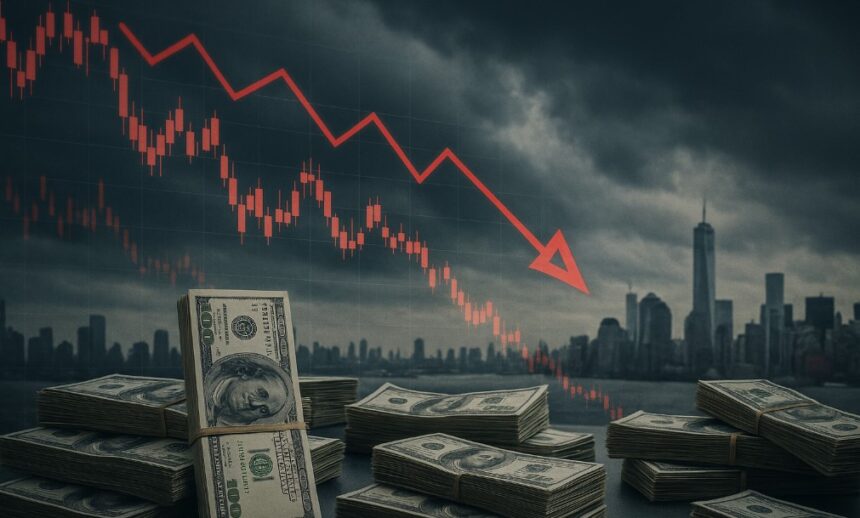Economist Henrik Zeberg, recognized for his anti-consensus predictions, once again turned on the alarm. After predicting market rebounds between 2023 and 2025, it issued the most powerful warning when many were hoping for a recession. A major financial crisis is beginning.
Based on the economic cycle model, Zeberg argues that the global economy is already in conflict with the collapse of “iceberg.” Despite the obvious boom in the stock market, All the signals ahead of the 2008 and 1929 crisisas well as reported encryption.
Next, we present ten keys to summarise the vision of the coming economic storm.
1. The Titanic has already hit an iceberg
Henrik Zeberg argues that the 2025 recession is not only likely, but according to him – it is inevitable. His economic cycle model is based on indicators and coincidence, indicating that historically significant thresholds ahead of the recession have already been exceeded.
In graphic terms it appears that the Titanic has already crashed on an iceberg. The damage is done and the only thing left is to expect the ship to sink.
Key indicators that incorporate signals such as construction permits, performance curves and new orders have already collapsed. Meanwhile, accidental indicators (employment, industrial production, income) begin to withdraw and confirm general degradation.
According to Zeberg, this pattern is repeated with surgical accuracy in all recessions over 80 years.
The following graph shows that the main indicator (red line on top panel) fell below its important baseline. And the matching indicator (red line on the bottom panel) follows that procedure It may also be below the limit. This, in the words of the analyst, indicates that the Titanic has already collided with the iceberg.
2. Consumers ignored by the Federal Reserve
Zeberg said the US Federal Reserve is looking at the economy on the other side of the telescope. If we focus only on low unemployment rates, it ignores the rapid deterioration of consumers, It represents 70% of America’s GDP.
Consumer trust surveys have collapsed and collapsed at historically relevant levels. The unemployment rate remains low, Trust is at the lowest point in over 10 years.
Zeberg warns that costs will inevitably decrease if households are discouraged by high prices, increased debt and low savings. This will drag the entire economy. He said current signals, such as loans and mortgage borrowing, indicate that consumers are exhausted.
3. The real estate market flashes red again
The real estate sector was the first problem indicator before the 2008 crisis. Today, that story repeats itself. The confidence of home builders has collapsed since peaking during the Covid-19 pandemic. It has fallen to a level that cannot be seen since 2012.
The NAHB HMI index has gone from 80 points in 2021 to just 32 points in June 2025. This sudden fall in the previous cycle A clear sign of serious economic problems. Every time the index collapses, the unemployment rate tends to shoot in a few months.
Zeberg points out that builders are cutting prices to aggressively reduce discounts and prices. This shows that they expect a strong slowdown in demand. Construction permit activity has also declined dramatically.
4. Employment is divided inside
The official US employment figures, major global financial strength, continues to show strength, but the second-level data tells a different story. Continued unemployment subsidy applications increased by 60% from the circular minimum in 2022. This is a clear sign of deterioration.
Zeberg emphasizes that this indicator is important. If workers are not able to get jobs quickly, it shows that the labour market is losing traction. This trend predated all recessions since the mid-20th century.
Furthermore, job openings have decreased from 11 million in 2022 to about 7 million. Temporary employment, voluntary resignations and salary growth have also declined. These are signs of decline in mature work cycles.
5. The largest stock market bubble in history
The current valuation of the US stock market, in particular, is at an unprecedented level. Zeberg compares the current situation with peaks in 1929, 2000 and 2007, but warns that the excess is even greater.
Today, US market capitalization accounts for more than 200% of GDP, exceeding the 140% “danger” threshold, which is expressed by Warren Buffett. In parallel, the S&P 500 index, like the largest historic roof, shows a price/profit ratio close to 30.
These levels are not only signs of overestimation; But the actual economy is disconnected. As can be seen in this graph, this product has increased 755% since 2008:
The massive creation of money combined with artificially inflated assets such as zero interest rates, actions, bonds, real estate, cryptocurrencies and more.
According to Zeberg, the only possible output of such a wide bubble is collapse. Or the price of the asset will fall or the value of the funds will collapse through uncontrolled inflation. Both routes hurt.
6. Markets and the economy: dangerous gaps
Zeberg highlights one of the most annoying current paradoxes. Financial markets celebrate with new maximums, but the actual economy is weakening. This cutting was either so obvious or not very long.
For example, since 2022, job offers have declined sharply, but the S&P 500 has continued to rise. Usually, these indicators move in parallel, Therefore, the current divergence is an alert signal.
Zeberg warns that this gap cannot be maintained indefinitely. Or the economy miraculously recovers (something unlikely) or the market is corrected towards reality. And the more illusions continue, he warned.
7. Cryptocurrency: Bubble of the last 10 years
According to Zeberg, the cryptocurrency market represents a speculative excess in its purest form. Memokines without actual utility have reached a multi-tens of billions of dollars valuation, such as Dogecoin (Doge) and Shiba Inu (Shib).
His analysis believes Zeberg is similar to the 2006 “toxic” asset fever. At the time, risk was hidden in opaque financial products. Today, volatile tokens are maintained only for speculative purposes.
The author warns that if the cryptocurrency market collapses in sync with the stock market, it could have an amp effect. It will not cause a crisis, But it can serve as an emotional trigger for common panic.
8. Bitcoin: Structural risks of corporate finances
Bitcoin (BTC) has now become an asset class accepted by businesses, funds and even governments. However, its high volatility, according to economists, A big risk for those who are balanced.
Companies like Strategy have accumulated almost 600,000 BTC, even with debt. If prices fall 80%, the company could become insolvent. It produces possible domino effects.
Zeberg fears that this institutional adoption of BTC is a new systematic weakness. Not because the assets themselves are wrong, That collapse can affect corporate balances, funds and general trust.
The author raises a scenario where Bitcoin can climb to US$150,000, followed by a sudden fall. In that context, the loss of exposed institutions is enormous and can lead to forced sales and panic.
9. Technical signal points to the roof
From technical analysis, Zeberg has identified multiple indications that the market is in the end of a bullish cycle process. The S&P 500 shows bearish divergence of indicators such as relative force index (RSI) and mobile average (MACD) convergence/divergence.
These divergences have already been seen before the roofs in 2000 and 2007. Prices continue to rise, Market internal forces decrease. This indicates that the upward trend is tired.
The current rebound is mostly guided by technical action, but the rest of the market is behind. This lack of amplitude is another symptom of bull cycle fatigue.
As you can see in the graph below, the S&P 500 touched on historic maximum this year, but the MACD and RSI are minimal.
10. What’s coming: Deflation and Stunflation
Zeberg foresees that the imminent crisis will begin with a collapse of deflation: falling asset prices, crises, and freezes in spending. Something similar to what happened in 2008 or even in your 30s.
Central banks respond with all their resources, including cutting functions, quantitative expansion, and massive fiscal stimulation. However, this time he warns that he couldn’t function like he used to.
That’s the big difference We are no longer in the age of structural peeling.. Starting in 2020, the 40-year-old inflation trend has been destroyed. Large public spending and minimum production capacity could create new regimes.
After deflationary shock, a stag stage can occur. Prices are rising, but growth is weak. This is a particularly difficult combination to control, both economically and politically.
Zeberg’s final message is clear. Emperor – the economy and markets are naked. The illusion of prosperity falls apart. And when the crowd finally sees it, it’s too late to run towards the exit. It’s better to cover yourself now.






